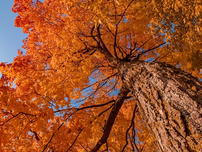top of page
Plant profile


Not your average plant: The bug-eating spoonleaf sundew
The spoonleaf sundew is a small carnivorous plant found in Will County. It lives in wet, acidic soil and supplements its diet by trapping and digesting insects with sticky, dew-like drops on its leaves. Though it looks delicate, this plant is a fierce predator and a great example of nature’s adaptability.


Marvelous maple trees really shine in fall
Maples bring vibrant fall colors and much more. Common species like silver, sugar, and box elder maples vary in size, leaf shape, and use. Sugar maples produce syrup and boast brilliant foliage. Silver maples are common in neighborhoods, while box elders have compound leaves and support forest wildlife. Maple wood is used in everything from sports gear to instruments. These trees are vital to nature and everyday life.


Unique cattails have many different uses
Cattails grow in wet areas and have unique ways to reproduce through seeds and underground rhizomes. Their parts are useful too! Leaves can make water-resistant string or soothe cuts, fluffy seeds can be used for fire-starting or insulation, and the tops can become torches. They’re even edible with adult guidance. While cattails are helpful to humans and wildlife, remember not to harvest them from protected areas like forest preserves.


Among trees, oaks are giants for many reasons
Oak trees are vital keystone species that support more life than any other tree in North America. They are among the longest-living trees in the world and provide food, shelter, and habitat to wildlife such as caterpillars. White oaks drop acorns yearly; red oaks, every other year. Oaks live for centuries and are known to be symbols of strength. Only 1 in 1,000 acorns becomes a tree, but the rest feed wildlife. Oak trees also played key roles in history, shipbuilding, and cul


Milkweed is a plant with many talents
Milkweed plants are important to both animals and humans. They are a great food source for monarch butterflies. They provide nectar to pollinators and can allow creatures to become toxic to predators by digesting its toxic sap. Milkweed has many medicinal uses including treating stings and respiratory issues. They are edible to humans if boiled in water, their stems can be used for ropes, their floss can fill pillows and blankets, and their pods make for great fire starters.
bottom of page